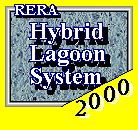
COPYRIGHTS
1999-2009 RERA
All right reserved.
Any Unauthorized
Copying
or Using Prohibited.
Preface
Table
of Contents
Foundation
Hybrid
Lagoon System
Case
Study
Applications
Proposals
12. The Hybrid Aerators System.
In hybrid lagoon systems, as rule aeration is performed with the prescribed aeration device placed at the center of the basin, forming a vertical aeration system. This vertical aeration system enables rapid diffusion of sludge throughout the basin with a minimum of liquid motion.
Further, prescribed mechanical aerators placed at the periphery and on the liquid surface in the hybrid lagoon basin comprise a horizontal aerator system. This enables surface liquid in the hybrid lagoon to flow along the periphery of the basin in a constant direction.
Through such a hybrid aeration system, which combines both vertical and horizontal aeration, the stirring characteristics and aeration efficiency required by the LLSB activated sludge treatment method are obtained.
As a means of reducing the site area required for hybrid lagoon facilities, the pressurized aeration method was developed (Photos 34 through 39); in this method, the basin is made deeper and a higher aeration efficiency realized, to attain the control characteristics required for high-performance treatment. As a result, hybrid lagoon facilities with a maximum liquid depth of 9 m and diameter of 32 m, and a capacity of 4,000 m3, have been constructed and are in operation. (Photos 19, 50).
The pressurized aeration method enables easy control of the intake volume without lowering the efficiency of oxygen introduction, thus making possible the kind of flexible aeration control necessary for denitrification processing. As a consequence, the following become possible.
Reduction of the energy required for high-performance processing.
Lowering of the costs of construction and of aeration facilities.
Efficient control even in the midst of fluctuations in the intake load.